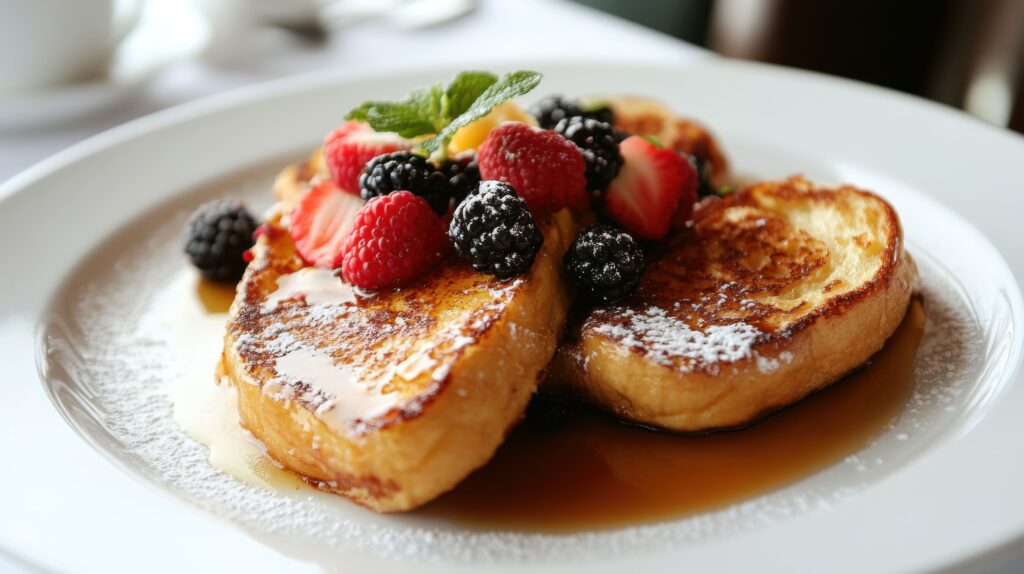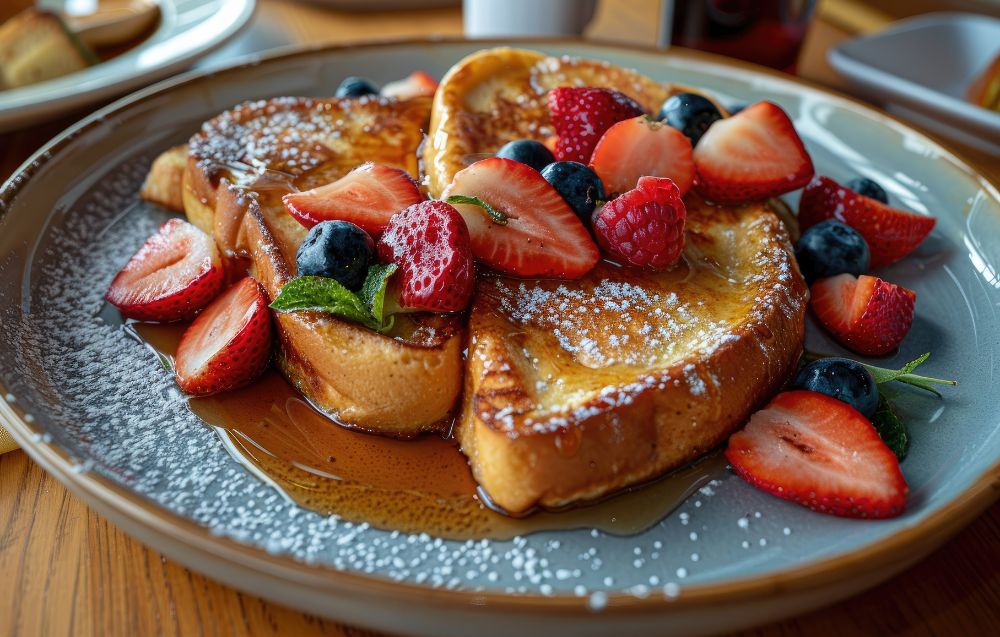Who doesn’t love French toast? It’s warm, comforting, and the perfect way to start your morning—or treat yourself to a delightful brunch. But have you tried making it with sourdough bread? If not, you’re in for a game-changing experience. Sourdough French toast combines tangy, hearty bread with a rich, velvety custard, fried to golden perfection. If you’re looking for new breakfast ideas, consider pairing this with easy protein granola to add a wholesome punch.
Introduction to Sourdough French Toast
Sourdough French toast, or “pain perdu” (meaning “lost bread” in French), was originally a way to revive stale bread. While many recipes use soft white bread, sourdough elevates the dish with its bold flavor and robust texture. If you’ve been curious about unique bread types, like sourdough or artisan Italian bread, this recipe is the perfect excuse to explore.
What Makes Sourdough Bread Unique?
Sourdough bread stands out for its fermentation process, which gives it a tangy taste and chewy texture. It’s also easier to digest, thanks to naturally occurring wild yeast breaking down gluten. This bread not only enhances the flavor but also ensures your French toast doesn’t become soggy or overly soft.
Why Sourdough is Perfect for French Toast
Here’s the deal: the wrong bread can completely ruin French toast. Soft bread often falls apart, while dense options fail to absorb the custard. Sourdough strikes the perfect balance—it’s sturdy enough to handle the soaking process and still turns soft and fluffy when cooked. Add a side of air fryer breakfast potatoes for a complete breakfast that’s nothing short of extraordinary.
“Sourdough French toast is like the friend who always brings something new to the table—bold, reliable, and full of surprises.”
Ingredients Needed for Sourdough French Toast
Let’s talk ingredients. The best part? You likely have most of these in your pantry already. Here’s your grocery list:

Selecting the Right Sourdough Bread
Not all sourdough is created equal. When making French toast, look for a loaf with a slightly firm crust and a soft interior. For an extra punch of flavor, choose a loaf that’s a day or two old—it absorbs custard better without falling apart.
Essential Ingredients for the Perfect Custard
The custard mixture transforms sourdough into melt-in-your-mouth French toast. Here’s what you’ll need:
- Eggs: The backbone of your custard, adding structure and richness.
- Milk or Cream: Whole milk or half-and-half works best. Want extra indulgence? Opt for heavy cream.
- Sugar: A touch of sweetness balances the tang of sourdough.
- Vanilla Extract: Brings warmth and depth to your dish.
- Cinnamon and Nutmeg: A pinch of spice enhances flavor.
- Salt: Just a dash to round out the sweetness.
Optional Additions for Enhanced Flavor
Why stop at the basics? Here are a few ways to elevate your French toast:
- Orange Zest: Adds a fresh citrus twist.
- Almond Extract: Offers a nutty aroma.
- Maple Syrup: Mixing it directly into the custard infuses sweetness throughout.
“Think of custard as the blank canvas, and spices and extracts as the brushstrokes that turn it into a masterpiece.”
For more information about Granola Bar or Protein Bar Nutrition Facts you can check this guide
Step-by-Step Guide to Making Sourdough French Toast
Ready to bring this masterpiece to life? Let’s go step by step.
Preparing the Bread: Tips and Tricks
Start by slicing your sourdough into thick pieces, about ¾ inch each. Stale bread works best—it absorbs the custard without becoming mushy. If your bread is fresh, let the slices air-dry for a few hours.
Mixing the Custard for Maximum Flavor
In a large bowl, whisk together eggs, milk, sugar, vanilla, and spices until smooth. Want an ultra-creamy custard? Blend the mixture for a few seconds to eliminate lumps.
Cooking Tips for Golden-Brown Perfection
Heat a non-stick skillet or griddle over medium heat. Add a dollop of butter and let it melt. Dip your bread into the custard, letting each side soak for a few seconds. Shake off any excess, then cook for 3–4 minutes per side until golden brown.
Step-by-Step Guide to Making Sourdough French Toast
Now that you’ve got all your ingredients ready, it’s time to transform them into the best breakfast you’ve ever had. This step-by-step guide will ensure your sourdough French toast comes out golden, fluffy, and packed with flavor.
Preparing Your Sourdough Bread
The foundation of great sourdough French toast starts with the bread itself. Slice your sourdough loaf into pieces about ¾ to 1 inch thick. Stale bread works best because it absorbs custard better without becoming too mushy. If your bread is fresh, don’t worry—you can leave it out for a few hours or lightly toast it to dry it out.
Pro Tip: When slicing, aim for uniform thickness to ensure even cooking.
Creating the Perfect Custard
The custard is where your sourdough French toast transforms into something magical. Here’s how to make it:
- Crack 4 large eggs into a mixing bowl. For the best results, choose fresh, high-quality eggs.
- Add 1 cup of whole milk or heavy cream for an indulgent texture.
- Sweeten it with 2 tablespoons of sugar or maple syrup.
- Add 1 teaspoon of vanilla extract and a dash of cinnamon and nutmeg. Learn how to pair cinnamon and nutmeg for maximum flavor.
- Whisk everything together until smooth.
Cooking to Perfection
Heat a large non-stick skillet or griddle over medium heat. Add a pat of butter and let it melt, creating a fragrant, golden base.
- Dip each slice of sourdough into the custard, letting it soak for about 10–15 seconds on each side.
- Carefully place the soaked bread onto the hot skillet.
- Cook for 3–4 minutes on each side, or until the bread is golden brown and slightly crispy around the edges.
Keep the heat moderate—too high, and you risk burning the butter or the bread.
Pro Tip: If cooking for a crowd, keep the finished slices warm in an oven set to 200°F while you work through the rest.
Creative Variations for Sourdough French Toast
One of the best things about sourdough French toast is how versatile it can be. From sweet to savory, the possibilities are endless.
Sweet Toppings and Additions
Want to take your French toast to the next level? Try these ideas:
- Fresh Fruits: Top with a handful of berries, banana slices, or juicy peaches.
- Whipped Cream: Add a dollop for an indulgent finish.
- Drizzles: Go classic with maple syrup or experiment with honey and caramel sauce.
- Nuts and Seeds: Sprinkle on chopped pecans, almonds, or chia seeds for extra crunch and nutrition.
Savory Sourdough French Toast
Yes, French toast can be savory too! Here’s how to switch it up:
- Skip the sugar and vanilla in your custard, and add a pinch of salt, pepper, and fresh herbs like thyme or parsley.
- Top your French toast with avocado slices, a poached egg, and a drizzle of hot sauce for a bold breakfast option.
- Pair it with a side of crispy bacon or sausage for a classic savory twist.
Vegan and Dairy-Free Alternatives
Don’t eat eggs or dairy? No problem! You can still enjoy a delicious plate of French toast.
- Egg Substitute: Use a mixture of flaxseed meal and water (1 tablespoon flaxseed meal + 2.5 tablespoons water = 1 egg).
- Milk Alternative: Swap in almond milk, oat milk, or coconut milk.
- Butter Alternative: Use plant-based butter or coconut oil.
Why Choose Sourdough? The Tangy Advantage
Sourdough isn’t just a trendy bread—it has real benefits. Thanks to its natural fermentation process, sourdough is easier to digest and has a distinct tangy flavor that balances the sweetness of French toast.
Pairing Your French Toast with the Perfect Beverage
Every great breakfast needs an equally great beverage. Here are a few ideas:
- Coffee: Pair with a bold, dark roast for a contrast to the sweet toast.
- Tea: Chai or Earl Grey work wonderfully, thanks to their warming spices.
- Juice: A glass of freshly squeezed orange juice adds a refreshing touch.
A Brief History of French Toast
Did you know French toast has been around for centuries? Originating as a way to use up stale bread, the dish was once called “pain perdu,” or “lost bread.” It has since become a staple breakfast food worldwide. Want to know more? Discover the origins of French toast and how it evolved into the dish we know and love today.
“French toast is like a time machine on a plate—it takes something old and makes it new again, one golden bite at a time.”
Common Problems and Simple Solutions
Even though sourdough French toast is straightforward to make, a few common hiccups can happen along the way. Don’t worry—I’ve got you covered with solutions to ensure your toast turns out perfect every time.
Problem 1: Soggy French Toast
Nobody likes a soggy piece of French toast. Soggy toast usually happens when the bread soaks up too much custard or the skillet isn’t hot enough.
Solution:
- Use slightly stale bread. Fresh bread absorbs more liquid and is more likely to fall apart.
- Keep your soak time short—about 10–15 seconds per side is enough.
- Preheat your skillet to medium before cooking. A hot pan sears the outside, creating a crispy crust while keeping the inside soft and fluffy.
Problem 2: Dry French Toast
On the flip side, dry French toast can happen if the bread doesn’t absorb enough custard or if you cook it too quickly.
Solution:
- Make sure your custard is well-mixed, with enough liquid for the bread to soak up.
- Let the bread sit in the custard for a moment, but don’t overdo it—about 15 seconds is ideal.
- Cook over medium heat to allow the custard to set evenly without drying out the bread.
Problem 3: Uneven Cooking
Sometimes you end up with toast that’s burnt in some spots and undercooked in others.
Solution:
- Use even slices of bread to ensure consistent cooking.
- Avoid overcrowding the skillet. Cook in batches if necessary, and wipe the pan clean between batches to remove burnt butter or crumbs.
Nutritional Benefits of Sourdough French Toast
While French toast is often seen as an indulgence, using sourdough bread brings a host of nutritional benefits to the table. Let’s break them down.
Easier to Digest
Sourdough bread is naturally fermented, which means it contains wild yeast and beneficial bacteria. These microbes partially break down gluten and starches during the fermentation process, making sourdough easier to digest compared to regular bread. This makes it a great choice for people with mild gluten sensitivities (though it’s not suitable for those with celiac disease).
Lower Glycemic Index
Unlike white bread, sourdough bread has a lower glycemic index, which means it causes a slower rise in blood sugar levels. When paired with a protein-rich custard, sourdough French toast becomes a more balanced meal that keeps you full longer.
Rich in Nutrients
Sourdough is packed with essential nutrients, including:
- B Vitamins: These support energy production and brain function.
- Iron and Magnesium: Important for oxygen transport and muscle health.
- Zinc: Helps with immune function and cell repair.
A Balanced Breakfast
Adding eggs, milk, and spices to your sourdough French toast turns it into a meal that’s both comforting and nourishing. You’ll get a balance of carbohydrates, protein, and healthy fats—everything you need to kickstart your day.
Tips for Serving and Presentation
Sourdough French toast is as much about presentation as it is about taste. A little extra effort can turn this breakfast staple into a show-stopping dish.
Plating Like a Pro
Here’s how to make your plate look Instagram-worthy:
- Stack your French toast slices slightly off-center to create height.
- Dust with powdered sugar for a touch of elegance.
- Add garnishes like fresh fruit or mint leaves for a pop of color.
Creative Topping Ideas
While the classic combination of butter and maple syrup is always a winner, why not get creative? Here are some topping ideas to inspire you:
- Fruit Compote: Simmer berries, peaches, or apples with a bit of sugar for a luscious topping.
- Whipped Mascarpone: Sweeten mascarpone cheese with a hint of vanilla and spread it over warm slices.
- Dark Chocolate Shavings: For an indulgent treat, sprinkle shavings of dark chocolate on top.
Pairing with Sides
Balance out your breakfast with complementary sides. Crispy bacon or sausage adds a savory contrast, while a small green salad can lighten the meal if served for brunch.
Sourdough French Toast for Different Occasions
Sourdough French toast is incredibly versatile and works for more than just a casual breakfast. Here’s how you can adapt it for various events.
Brunch Gatherings
Hosting a brunch? Prepare a French toast bar with a variety of toppings so guests can customize their plates. Include sweet options like fresh fruit, whipped cream, and syrups, alongside savory add-ons like avocado, smoked salmon, or soft-boiled eggs.
Holiday Breakfasts
For special occasions like Christmas or Easter, dress up your French toast with festive flavors. Add a pinch of gingerbread spice to the custard or top with a cranberry-orange compote for a holiday twist.
Dessert Options
Yes, you can turn French toast into dessert! Layer slices with mascarpone and fruit for a French toast cake, or top with vanilla ice cream and caramel sauce for a decadent treat.
Final Tips for Perfect Sourdough French Toast
Here are a few last tips to ensure your French toast turns out flawless every time:
Prep Ahead
If you’re short on time in the morning, prep everything the night before. Slice the bread, mix the custard, and store it in the fridge. In the morning, just dip and cook.
Experiment with Flavors
Don’t be afraid to think outside the box. From adding citrus zest to your custard to experimenting with savory flavors, there’s no limit to the variations you can try.
Keep It Warm
If you’re making a large batch, keep the cooked slices warm in an oven set to 200°F. This keeps everything toasty without drying it out.
“Sourdough French toast is more than just breakfast—it’s an experience, a celebration of flavors, and the ultimate comfort food to share with those you love.”
Wrapping It Up
Sourdough French toast is a delightful twist on a classic recipe that’s perfect for any occasion. Whether you’re serving it for a casual breakfast, an elegant brunch, or even as dessert, it’s a dish that never fails to impress. Armed with this guide, you’re now ready to create your own masterpiece—crispy, custardy, and completely irresistible.
Conclusion: Why Sourdough French Toast Belongs on Your Table
Sourdough French toast isn’t just breakfast—it’s a delightful culinary creation that blends the tangy, hearty flavor of sourdough bread with the creamy richness of spiced custard. Its appeal lies in its versatility, perfect as a cozy weekday indulgence or a show-stopping brunch centerpiece.
The unique texture of sourdough elevates the dish, while the endless options for toppings—from fresh fruit to whipped cream—make it both comforting and exciting. With the tips, tricks, and variations shared here, you’re equipped to create a plate that’s golden, fluffy, and irresistibly delicious. Grab your sourdough loaf, prepare your custard, and treat yourself to a breakfast experience that’s truly unforgettable!

